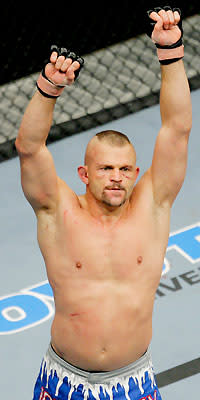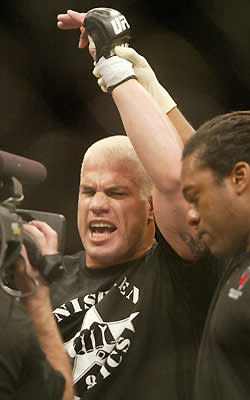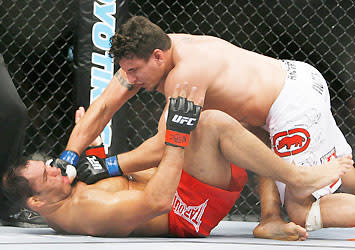'TUF' coaches fights a business boon
The June 12 match between Chuck Liddell, and his fill-in "Ultimate Fighter" coaching adversary Rich Franklin, in Vancouver will mark the ninth battle between coaches in the 11-season history of the series.
While television commercials are pushing that the two men, who coached in the first and second seasons of the show in 2005, are gearing up for another championship run, the reality is different. Liddell (21-7) is now 40 years old, and has lost four of his last five fights. Last year, after a knockout loss to Mauricio "Shogun" Rua, Liddell – who even at that point was one of the company’s biggest drawing cards – was declared retired by UFC president Dana White. As with most fighter retirements, it was short-lived.
Franklin (27-5-1), 35, a former middleweight champion, has fared better in recent years, but is coming off a first knockout loss to Vitor Belfort in his last fight on September 19 in Dallas.
When people talk about the UFC's flagship reality show, the discussion usually centers on the stars created off the show, such as Forrest Griffin, Josh Koscheck Diego Sanchez, Rashad Evans and Michael Bisping. Or it turns to the now-legendary Griffin vs. Stephan Bonnar fight in the first Ultimate Fighter finale.
But as the current season showed, with Tito Ortiz being dumped as coach with just five days left in the filming because neck surgery wouldn’t allow him to face Liddell as scheduled, the season is also about the pay-per-view match between the coaches after the series airs.
The UFC's business model is based on pay-per-view business. Thirteen weeks of exposure on basic cable's Spike TV is a tremendous vehicle for building a big fight, and no greater example of this was Saturday’s Quinton Jackson vs. Evans bout, the most successful non-title fight in company history. While the coaches matches haven’t had many classic results, in almost every case, they’ve led to business success on pay-per-view.
A rundown of the prior matches:
Season one: Chuck Liddell vs. Randy Couture, April 16, 2005, Las Vegas: At the time, Couture, approaching his 42nd birthday, was UFC light heavyweight champion and the company’s biggest star. With the first TUD season bringing UFC to basic cable for the first time, hundreds of thousands of new fans had been created over the prior three months. Liddell won the title with a first round knockout. By getting the right kind of win at the right time, Liddell became the biggest draw in the sport for the next few years. The showdown set a company record for live gate ($2,575,450) and on pay-per-view (280,000 buys). While both numbers seem modest today, to show the difference television made, the first Liddell vs. Couture match two years earlier did just 75,000 buys. This match was significant not only in Liddell’s rise to fame, but the company’s as well. The battle of the coaches formula was shown to be a big-time moneymaker on pay-per-view, and still is today.
Season two: Coaches were Matt Hughes and Rich Franklin, who due to being in different weight classes, opted not to fight. However, the exposure from coaching turned them into much bigger stars than they were before the show, who are still among the best-known fighters today.
Season three: Tito Ortiz vs Ken Shamrock, July 8, 2006, Las Vegas: This season and fight was the promotional blue-print for some of the biggest events in company history. While Liddell and Couture in season one were the two biggest stars, as rival coaches, they came across as two nice guys. From watching the show, they could have mistaken for best friends, which they were not. But there was no grudge match element promoted, just a battle between for a championship.
Ortiz vs. Shamrock had issues dating back seven years. There were a lot of skeptics when the match was announced. Ortiz beat Shamrock in a one-sided fight nearly four years earlier. Shamrock at this point was 42, and his reaction time had clearly slowed in a first round knockout to Franklin. Insiders saw this as a one-sided fight. But with the build-up on television, during what was the highest-rated season of the series pre-Kimbo Slice, the match destroyed all company business records, with a $3,452,123 gate, and 775,000 buys on pay-per-view. Ortiz took Shamrock down and hit him with several hard elbows on the ground, and ref Herb Dean stopped the match in 1:18.
Shamrock, as well as many fans, complained it was stopped early, which set up a third match, which Ortiz won almost as quickly and with no controversy. But the business results showed, regardless of where a fighter stood in terms of age or previous losses, the power of a television-built grudge match.
Season four: This was the only season the show had no official coaches, as they brought in different stars to work as coaches each week. However, they did make sure and bring in Matt Hughes and Georges St. Pierre at the same time, leading to St. Pierre’s first welterweight title win on November 18, 2006, in Sacramento.
Season five: B.J. Penn vs. Jens Pulver, June 23, 2007, Las Vegas: The grudge match element was strong all season, as Penn clearly disliked Pulver, who had beaten him five years earlier. But their respective careers had gone in different directions. Penn was considered by this point one of the most talented fighters in the sport, looking to avenge that early loss, but Pulver had become largely a journeyman fighter by that time.
Penn talked about winning the fight as being a foregone conclusion, and it turned out to be, as Pulver spent most of the fight just trying to survive, before being choked out at 3:12 of the second round. As a favor to Spike TV, this match was put on The Ultimate Fighter final, where it did the fifth-highest rating for a UFC televised event up to that point.
Season six: Matt Hughes vs. Matt Serra, May 23, 2009, Las Vegas: This was marketed as another grudge match. The issues between the two stemmed from season four. Serra was a competitor and Hughes was a guest coach, and Serra was vocal in making fun of Hughes as the stereotypical high school jock bully. Serra not only won the tournament, but went on to beat St. Pierre in one of the sport’s biggest upsets in history to become the welterweight champion. The original goal of this show was to build a title match at the end of 2007. However, Serra suffered a serious back injury. St. Pierre, his replacement, beat Hughes, knocking him out of contention. St. Pierre then beat Serra in the rematch.
Between injuries to both men, and Serra’s wife giving birth, the fight actually took place 17 months after it was originally scheduled. Hughes won a close decision.
But there was a major lesson here. Some felt all the long delay would have made people no longer care about the match, but it was clear on that day, the long delay simply made fans crave the match even more. It was important, because later, when something similar happened with Quinton Jackson and Rashad Evans, the promotion knew the match not taking place immediately after the season was not a disaster.
Season seven: Quinton Jackson vs. Forrest Griffin, July 5, 2008, Las Vegas: The expectation was with two strong personalities, this would be one of the most entertaining seasons. And while the show did have moments, it never quite lived up to that. The fight, on the other hand, didn’t have such high hopes as it was largely expected Jackson was a level above Griffin, who had become one of the sport’s most popular fighters after his win over Bonnar in the first season finale.
Nobody really considered Griffin as someone who would ever become champion. Instead, in what was easily the best of these coaches fights, Griffin captured the light heavyweight title in a close five-round decision that was a fight of the year candidate.
Season eight, Antonio Rodrigo Nogueira vs. Frank Mir, December 27, 2008, Las Vegas: There was no strong personality conflict here with the coaches, as Mir idolized Nogueira, but his cockiness on the show made him a polarizing figure, against the ultra-polite Brazilian. Few figured Mir had much of a chance in taking on the interim heavyweight champion.
Nogueira was generally considered the second best heavyweight in the sport’s history, an iron man who had never been stopped in a fight. Mir himself even remarked that for the first time, he was in with somebody that even if he did everything right, he still may not be able to beat.
As it turned out, Mir did what was considered the unthinkable, dominating Nogueira standing and knocking him out at 1:57 of the second round to win the title. Nogueira wasn’t himself that night, coming off a staph infection hospitalization, and those close to him had urged him to pull out of the fight.
Season nine, Dan Henderson vs. Michael Bisping, July 11, 2009, Las Vegas: Henderson, a former two-time U.S. Olympian in Greco-Roman wrestling, and Bisping, the most well-known U.K. fighter, were coaches in a Team U.S. vs. Team U.K. season. It was a unique dynamic, since Bisping’s antics made him super popular in the U.K. and hated in the U.S. with his cocky attitude played up against the quiet and reserved Henderson, who had vowed to take out his frustrations on Bisping in the match. As part of UFC 100, the biggest money MMA event in history, doing a record setting 1.6 million pay-per-view buys, Henderson stopped Bisping at 3:20 of the second round by brutal knockout.
Season 10, Quinton Jackson vs. Rashad Evans, May 29, Las Vegas: Due to the presence of Kimbo Slice as a cast member, the weekly antics between the two played out before largest audience ever to watch to show. Jackson vs. Evans rivaled Shamrock vs. Ortiz as the biggest grudge match in the show’s history. But the difference was, Jackson vs. Evans was a pick-em fight between two former light heavyweight champions still in their prime. While the pre-show hype promised a brawl, Evans did everything to avoid that, fighting a smart technical fight, playing to his advantages in speed and conditioning, and won the decision.



